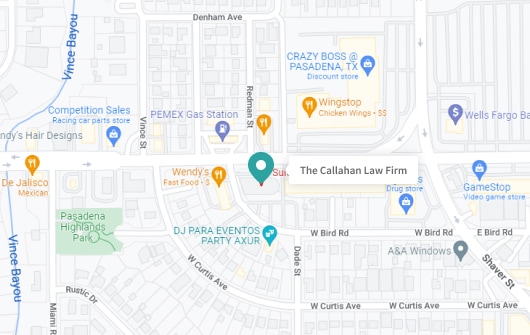Aortic Dissection Injuries (Torn Aorta) From Car Accident in Houston

The aftermath of a car accident frequently leads to physical injuries that can alter the course of an individual’s life. One such injury, rarely discussed yet crucial for individuals and their families to comprehend, is experiencing a tear in the aorta, often referred to as aortic dissection.
Early recognition and treatment of symptoms is essential for ensuring your health and well-being. Additionally, the legal and financial implications of such a severe injury necessitate a comprehensive understanding of how to seek appropriate compensation. In these situations, it’s absolutely essential to hire a personal injury lawyer.
For legal assistance with cases involving aortic dissection after car accidents, we’re here to help. With 25 years of experience, The Callahan Law Firm brings a wealth of knowledge and a proven track record of success in navigating the complexities of personal injury law. Contact us today to schedule a no-cost consultation.
Torn Aorta or Aortic Dissection Can Occur in High-Speed Accidents in Houston
A torn aorta from car accidents is a severe and potentially fatal injury that involves a tear in the inner layer of the aorta, the large blood vessel branching off the heart, allowing blood to flow between the layers of the blood vessel wall. In car accidents, especially those involving high-speed impacts, the forces can cause the layers of the aorta to separate, leading to this severe injury.
Symptoms and Diagnosis of Aortic Dissection
Recognizing the symptoms and ensuring prompt diagnosis are crucial for survival. Common symptoms of aortic dissection include:
- Sudden severe chest or upper back pain, often described as a tearing, ripping, or sharp sensation, which can radiate to the neck or down the back
- Intense abdominal pain
- Shortness of breath, difficulty breathing, or wheezing
- Fainting or dizziness, often due to a decrease in blood flow to the brain
- Weakness, paralysis, or numbness
- Absence of a pulse in the arms or legs
- Different blood pressure in the right and left arm
- Sudden difficulty speaking, loss of vision, or other symptoms resembling a stroke
If you have any of the above listed symptoms you should seek medical attention immedately to be evaluated by a physician.
Importance of Immediate Medical Attention and Prompt Diagnosis
Prompt medical attention is critical upon experiencing any of the above symptoms of an aortic dissection. Due to its potential to quickly become fatal, immediate diagnosis and treatment can be life-saving. Diagnosis typically involves imaging tests such as:
- A Computed Tomography (CT) scan, which diagnoses a torn aorta by producing detailed cross-sectional images of the body, using X-rays and computer technology. This imaging technique allows doctors to visualize the aorta in great detail and identify any abnormalities, including the presence, location, and extent of an aortic tear.
- Magnetic Resonance Angiogram (MRA), which focuses specifically on the body’s blood vessels. It can effectively diagnose an aortic dissection by providing clear visualizations of the aorta, allowing healthcare providers to identify the presence of a dissection, its location, and extent
- Transesophageal Echocardiogram (TEE), which allows healthcare professionals to visualize the aorta and determine the presence and extent of a dissection.
Early and accurate diagnosis is essential for guiding treatment decisions, which may include medications to lower blood pressure and heart rate or emergency surgery to repair the dissection.
Treatment and Recovery Process
Aortic dissection is a severe medical emergency that requires immediate treatment to prevent fatal complications. In the fortunate event of timely diagnosis, several treatment options are available to manage aortic dissection:
Acute Management
Upon diagnosis, individuals are usually admitted to the intensive care unit (ICU) for close monitoring and administered medications to control blood pressure, as pressure exacerbates the risk of aortic rupture.
Surgery
Surgical intervention is the primary course of action for aortic dissection. The specific approach – whether it’s open-heart surgery or an endovascular repair – depends on the location and severity of the tear.
Long-Term Recovery
After surviving an aortic dissection, a long-term recovery journey begins. This often involves a period of vigilant monitoring of the heart and aorta, typically with regular imaging tests. It is not uncommon for survivors to experience psychological trauma, anxiety, and depression as well.
Complications and Follow-Up Care
Recovery can be complicated by various factors, including further dissection, aneurysm formation, or problems with the heart’s valves. Follow-up care with a cardiologist or vascular surgeon is critical to monitor and manage these additional concerns.
What are the Legal Considerations After Aortic Dissection?
Beyond the physical, the aftermath of a traumatic aortic dissection extends into employment, insurance, and overall quality of life issues. After this type of accident, you may have an option to obtain compensation from the party who caused the accident.
Filing an Insurance Claim and Dealing with Insurance Companies
Insurance companies often aim to minimize their payouts, potentially offering settlements that are less than the injured party deserves or denying claims outright. An experienced attorney can be invaluable in dealing with insurers, ensuring that your rights are protected throughout the claims process.
Your attorney can handle all communications with the insurance company, counter unreasonably low offers, and, if necessary, take legal action to secure the compensation you deserve.
Filing a Personal Injury Claim
In Texas, initiating a lawsuit to seek compensation for injuries involves filing a legal complaint against the responsible parties in a civil court. It’s critical for plaintiffs to be mindful of Texas’s statute of limitations, which dictates the timeframe within which legal action must be taken.
For personal injury claims in Texas, this period is typically two years from the date of the injury. Failing to file within this timeframe can result in the loss of the right to seek compensation. An experienced attorney in Texas can ensure that your lawsuit is filed correctly and within the legal deadlines.
The Role of Comparative Fault in Texas
In Texas, the concept of comparative fault plays a crucial role in determining compensation in personal injury cases, including those involving aortic dissection from a car accident. Texas follows a modified comparative fault rule, also known as proportionate responsibility, where the amount of compensation you can receive is reduced by your percentage of fault in the incident. However, if you are found to be more than 50% responsible for the accident, you are barred from recovering any compensation at all.
For example, if the court determines that you are 30% at fault for the circumstances leading to your injury, and your total damages amount to $100,000, you would be eligible to receive 70% of that amount, or $70,000. If your fault exceeds 50%, you would not be entitled to compensation under Texas law.
The Role of a Lawyer in Aortic Dissection Cases
Navigating the legal aftermath of an aortic dissection is a task that calls for professional legal assistance. A lawyer with experience in personal injury or medical malpractice cases can offer invaluable assistance:
- Case Evaluation: An experienced lawyer can provide a comprehensive evaluation of your case, identifying the key elements that need to be proven, such as the duty of care breached by the other party and the direct link between that breach and your injury.
- Evidence Gathering: Lawyers have the resources and know-how to collect the necessary evidence to support your claim. This might include medical records, expert witness testimonies, and other pertinent documentation.
- Negotiation: Many personal injury cases are settled out of court. A skilled lawyer can negotiate with insurance companies or opposing counsel to secure a fair settlement that adequately covers your damages.
- Litigation: If a fair settlement cannot be reached, your lawyer will be prepared to take your case to trial, advocating on your behalf to ensure that justice is served.
In aortic dissection cases, the role of a lawyer is indispensable, as they provide critical legal guidance.

Recoverable Damages in an Accident Case Involving Aortic Rupture or Dissection
The damages recoverable in a personal injury claim involving aortic dissection are based on the specifics of the case. However, the most common types include:
- Medical Expenses: This covers all current and future medical costs related to the aortic dissection and its treatment.
- Lost Wages: An injury of this magnitude can result in an extended period of missed work. Damages account for lost income and potential earnings.
- Pain and Suffering: Aortic dissection can cause immense physical suffering and mental anguish, and these damages seek to compensate for the intangible costs of this suffering.
- Punitive Damages: Courts may award punitive damages to punish particularly negligent or malicious behavior.
It is your legal team’s responsibility to assess the appropriate compensation level and advocate for the maximum amount allowed under the law.
Getting Help from a Houston Auto Accident and Injury Lawyer
It’s crucial to secure legal representation from our Houston car accident lawyers, as we have experience in handling many different types of personal injury cases and understand the complexity of your injury. When you work with The Callahan Law Firm, you get the following benefits:
Knowledge of Handling Aortic Dissection Cases
Not all personal injury lawyers are equipped to handle the complex and critical nature of cases involving aortic dissection. Our lawyers are experienced in these cases and have the necessary medical and legal knowledge to build a strong case on your behalf.
Commitment to Client Care and Success
The Callahan Law Firm prioritizes client care, providing personalized attention. We are not only knowledgeable and experienced in our practice areas but also deeply empathetic, understanding the emotional and financial toll an accident and the legal process can take on individuals and families.
If you’ve experienced aortic dissection following a car accident, you may be entitled to compensation. Don’t let medical bills and pain rule your life. Contact The Callahan Law Firm to schedule a no-cost consultation to discuss your legal options with one of our car accident lawyers.
FAQ
Which Types of Motor Vehicle Crashes Cause Ruptured Aortas?
Ruptured aortas are a severe and potentially life-threatening injury often resulting from motor vehicle crashes, with certain types of accidents posing higher risks.
- Frontal collisions, due to the intense deceleration forces, can cause the heart and aorta to move abruptly forward, leading to tears.
- Side-impact (T-bone) crashes exert significant lateral forces, making them particularly dangerous for causing aortic ruptures.
- Even though rear-end collisions are generally viewed as less severe, at high speeds, they can still lead to serious injuries including aortic ruptures.
- Rollover accidents involve violent, twisting forces that can also result in aortic damage.
- High-speed collisions and accidents involving large commercial vehicles, such as trucks and buses, due to their size and weight, significantly increase the risk of severe trauma like aortic ruptures.
Safety measures like seat belts and airbags can mitigate some risk, but the combination of speed, force, and impact direction in these crashes often makes aortic injuries a critical concern.
How Common Are Aortic Rupture Cases in the United States?
Aortic ruptures are a critical concern in the United States, particularly in the context of motor vehicle crashes involving sudden deceleration. They account for approximately 16% of fatalities in such incidents, underscoring the severe risk associated with high-impact collisions.











